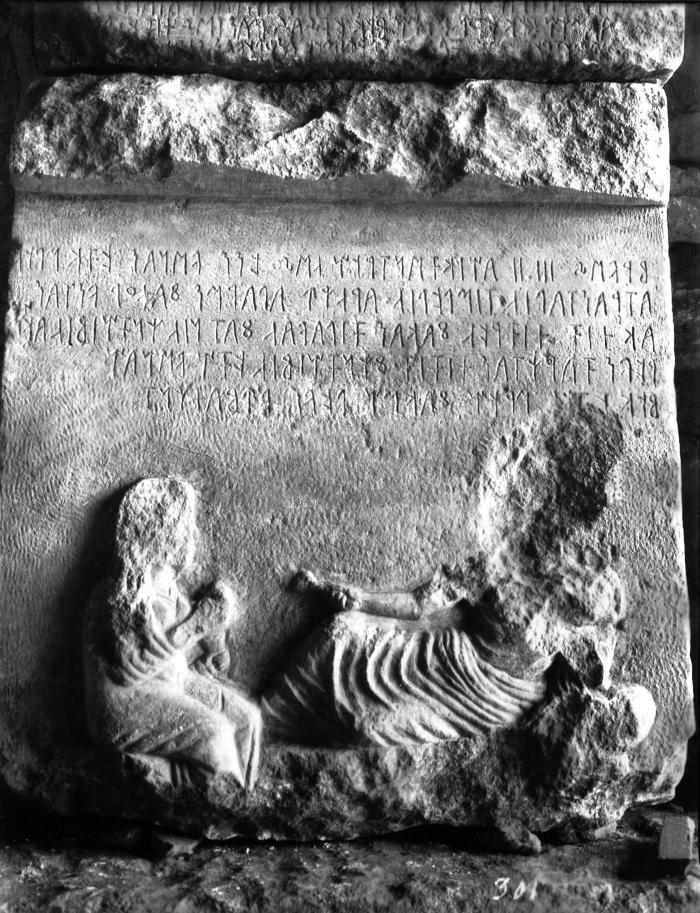Timles'in oğlu Atrastas'ın Mezar Steli
- Dönem
- 330-329 BC, Hellenistik
- Müze
- İstanbul Arkeoloji Müzeleri, 4030
- Müze Envanter No.
- 4030
- Sardeis veya Müze Env. No.
- IAM 4030
- Malzeme
- Mermer, Taş
- Eserin Türü
- Heykel
- Heykelin Türü
- Stel, Cenaze Kabartması, İnsan Figürü
- Yerleşim
- Sardis
- Bulunduğu Yeri
- "Found on May 26, 1913, in a roughly built wall closing the doorway of a single-chamber tomb ... about 20 m. above the ravine on which faced the 'Stele tomb'" (Sardis VI, 2, 7). At Istanbul since Sept. 1924.
- Tanım
C. H. Greenewalt, Jr. noted that at the top, the relief molding has painted egg and dart motif, yellow with black background. There are five lines of text in Lydian, with red preserved in some letters. Below the text is a sculptured scene showing a man reclining on a couch, at the left end of which sits a woman turned toward him. His left elbow is propped on a cushion, while his right hand resting upon his right knee holds some small object, perhaps a flower. His head is turned, facing outward. He wears a garment which comes behind the back over the I. arm and across the body in linear folds, reminiscent of Persian-Palmyrene garments. A cloak is draped in sharp-ridged folds across his legs. The incised strands of hair fall on the woman's shoulders. She is wrapped in a cloak which also goes around her r. arm. Apparently she, too, held some object. Her breasts are indicated.
Compared to the elaborate family scene in the pediment Cat. 18 (Figs. 72-74), the funerary meal is reduced to the two-figure formula and is close to some Hellenistic representations of which great numbers are known (Fıralı, Stelès, 18ff., pls. 8ff.; E. Pfuhl, Spätionische Plastik, 35ff., figs. 18-23, esp. 21). Unlike Hellenistic stelai, however, the group is not framed by architecture. The style is provincial and awkward, but it may reflect Near Eastern-Iranian connections in the linear fold renderings.
The following is from the German translation by R. Gusmani (letter Feb. 1972):
In the year 5 (under) Alexandros given (dãn ) (. . . . ). This grave chamber and this stele/ (belong to) Atrastas (the son) of Timles; from his expense (. . . . ) the heir himself dedicated (?)/ Now whosoever (this stele) protects and not damages/ to him/ Zeus is well disposed; but whoever damages this grave chamber or this stele, him Zeus will destroy.
The Lydian, bruãn III II aliksantrul dãn ... is the dating formula which yields the date 334, conquest of Asia Minor, less 5, equals 330-329 B.C. The god translated "Zeus" is Levs equated by H. Th. Bossert and others with Deus, Zeus. Dãn may be "datum," "data res."- Condition
"Local" marble.
Broken at bottom, below top of couch, front of top profile. Upper part of man's figure, face, I. hand, lower legs of woman, front of couch lost. Top element and finial probably missing.
- Boyutlar
- H. 0.61, of relief 0.34; W. at top 0.56, at bottom 0.57; Th. of molding without relief 0.13; H. of molding 0.10; projection 0.04, previously more.
- Yorum
- Ayrıca bakınız
- Kaynakça
- Published: Sardis VI, 1, 54-55, L. 26: Sardis VI, 2, 7f., no. 3, pl. II; Hanfmann, Pediment, 296f., pl. 102b; Bossert, Altanatolien, 27, fig. 193; Pfuhl-Möbius, Ostgriechischen Grabreliefs, no. 76, pl. 19. See Gusmani, Lydisches Worterbuch, 251, no. 3, for complete inscription. Mentioned in E. Pfuhl, Spationische Plastik; Gusmani, Lydiaka, 272.
- Yazar
- NHR
